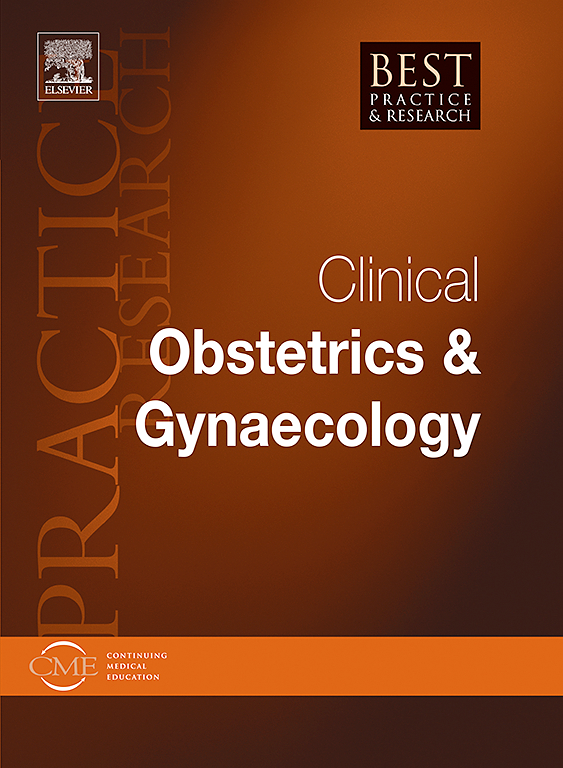了解、检测和处理溶血性疾病对胎儿和新生儿的“晚期”贫血。
IF 4.1
2区 医学
Q1 OBSTETRICS & GYNECOLOGY
Best Practice & Research Clinical Obstetrics & Gynaecology
Pub Date : 2025-07-23
DOI:10.1016/j.bpobgyn.2025.102650
引用次数: 0
摘要
65年前首次描述的胎儿和新生儿溶血性疾病(hddn)的“晚期”贫血,至今仍未被完全了解,治疗方法也不一致。我们怀疑,在了解其发病机制和促进其管理一致性方面的缺陷可以通过团队合作来通过多中心试验来测试最佳想法来弥补。我们首先提出一个基于数据的贫血定义,以及出生时和新生儿期婴儿的“严重”贫血定义。然后,我们回顾了早期和最近关于HDFN“晚期”贫血的报道,表明存在两种致病性形式;溶血性与非溶血性(低生产力)。然后,我们回顾了在任何给定情况下使用非侵入性和快速的方法来区分这两种可能性。接下来,我们回顾了预防“晚期”贫血的方法,或者在不输红细胞的情况下使用促红细胞生成素(达贝泊丁或促红细胞生成素)治疗。我们提出了我们首选的方法,使用达贝诗丁,并解释了我们认为的主要优点。我们呼吁在每个新生儿重症监护病房制定输血管理计划,建立新生儿重症监护病房输血指南,定期评估依从性,并为问题病例提供建议。此外,这些规划可以支持在新生儿重症监护病房住院期间和出院后数周内管理HDFN新生儿的一致方法。我们以差距分析结束这篇综述,并呼吁开展新的重点研究,旨在为这些患者带来更好的结果,减少这些家庭的不确定性和压力。本文章由计算机程序翻译,如有差异,请以英文原文为准。
Understanding, detecting, and managing the “late” anemia of hemolytic disease of the fetus and newborn
The “late” anemia of hemolytic disease of the fetus and newborn (HDFN), first described over 65 years ago, remains incompletely understood and inconsistently treated. We suspect that deficiencies in understanding its pathogenesis and fostering uniformity in its management could be remedied by teams working collaboratively to test the best ideas through multicentered trials. We begin this review by proposing a data-based definition of anemia, and of “severe” anemia, among infants at birth and during the neonatal period. We then review early as well as recent reports of the “late” anemia of HDFN, suggesting that two pathogenic forms of the condition exist; hemolytic vs. non-hemolytic (hypoproductive). We then review the use of a noninvasive and rapid means of differentiating between these two possibilities, in any given case. Next, we review means of either preventing the “late” anemia or treating it without red blood cell transfusions, using erythropoietic stimulating agents (darbepoetin or erythropoietin). We present our preferred method, using darbepoetin, and explain what we see as the chief advantages. We call for the development of transfusion stewardship programs in each NICU, to establish NICU transfusion guidelines, periodically evaluate compliance, and provide advice for problem cases. In addition, these programs can endorse a consistent approach to managing neonates with HDFN, during their NICU stay and for the weeks after discharge. We end the review with a gap analysis and a call for new focused research aimed at producing better outcomes for these patients, and less uncertainty and stress for these families.
求助全文
通过发布文献求助,成功后即可免费获取论文全文。
去求助
来源期刊
CiteScore
9.40
自引率
1.80%
发文量
113
审稿时长
54 days
期刊介绍:
In practical paperback format, each 200 page topic-based issue of Best Practice & Research Clinical Obstetrics & Gynaecology will provide a comprehensive review of current clinical practice and thinking within the specialties of obstetrics and gynaecology.
All chapters take the form of practical, evidence-based reviews that seek to address key clinical issues of diagnosis, treatment and patient management.
Each issue follows a problem-orientated approach that focuses on the key questions to be addressed, clearly defining what is known and not known. Management will be described in practical terms so that it can be applied to the individual patient.

 求助内容:
求助内容: 应助结果提醒方式:
应助结果提醒方式:


